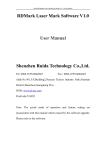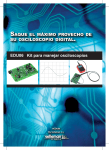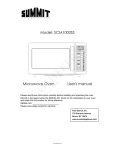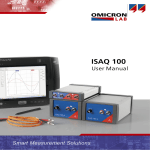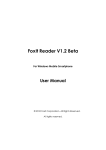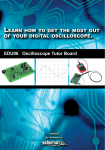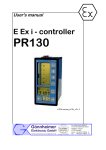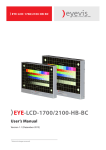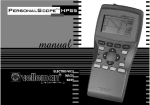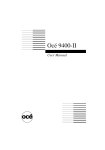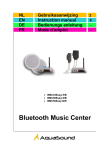Download 2CH wlan Digital Storage Oscilloscope
Transcript
WFS210 2CH WLAN DIGITAL STORAGE OSCILLOSCOPE WFS210 help manual for use with the PC & tablet © 2014 Velleman NV 2 Contents Table of Contents Foreword Part I Introduction 1 Part II General information 2 1 Specifications ................................................................................................................................... & Features 2 2 Safety ................................................................................................................................... & Warnings 3 3 Measuring ................................................................................................................................... Probe 4 Probe com pensation ......................................................................................................................................................... 5 Part III Digital storage oscilloscope 6 1 Indications ................................................................................................................................... 6 2 Connections ................................................................................................................................... 7 3 Charging ................................................................................................................................... the battery 7 Part IV PC application 8 1 Overview ................................................................................................................................... 8 2 Menu ................................................................................................................................... options 8 3 Indications ................................................................................................................................... 9 4 Software ................................................................................................................................... controls 9 5 Trigger ................................................................................................................................... level 11 Part V Tablet application 12 1 WFS210 ................................................................................................................................... application 12 2 Measuring ................................................................................................................................... with Apple / Android 13 3 Gestures ................................................................................................................................... for tablet 14 Part VI Oscilloscope Terms 15 1 - A................................................................................................................................... 15 2 - B................................................................................................................................... 15 3 - C................................................................................................................................... 15 4 - D................................................................................................................................... 16 5 - E................................................................................................................................... 17 6 - F................................................................................................................................... 17 7 - G................................................................................................................................... 17 8 - H................................................................................................................................... 17 9 - I ................................................................................................................................... 17 10 - N................................................................................................................................... 18 11 - P................................................................................................................................... 18 12 - R................................................................................................................................... 18 13 - S................................................................................................................................... 19 © 2014 Velleman NV 3 Contents 19 14 - T................................................................................................................................... 15 - V................................................................................................................................... 19 16 - W................................................................................................................................... 20 © 2014 Velleman NV Company profile by Velleman NV Velleman® nv has b een an important wholesaler and developer of electronics for over 36 years. Our warehouses contain more than 18 000 different products of 50 b rands. The distrib ution network includes more than 1700 distrib utors in well over 85 countries. Velleman® nv has b uilt up an excellent service reputation towards retailers. To meet the ever increasing growth, Velleman® nv expanded with new offices and showrooms as well as a new warehouse of 35 000m³ equipped with the latest in order picking technology. This represents an investment of over € 5 500 000. Our company • own research & development-department with over 30 years of technical knowledge • sales to "do-it-yourself"-shops and mass distrib ution of the Perel b rand. • sales to electronics stores • export department • common industrial products department • present at electronics fairs all over the world •kits production within the company • sales offices in Spain, France, the Netherlands, Sweden, Poland and Belgium • sales office and warehouse of 20 000 ft² in the United States • warehouse: 15 000m² • Velleman purchase office in China, Hong Kong and Taiwan • service and repair department for technical assistance and repairs • quality control of each purchased product • a high degree of automation and computerization thanks to our IT department • own graphical department for design of packaging and catalogs, and the preparation an translation of user manuals • different showrooms per division 1 Introduction 1 Introduction WFS210 2CH wlan Digital Storage Oscilloscope The Velleman WFS210 is the world’s first Wlan dual channel digital storage oscilloscope geared towards tablet computers, it's a compACt, portable, battery powered, fully featured two channel oscilloscope. As opposed to traditional oscilloscopes, it does not feature a screen. Instead of a built-in screen it uses your tablet iOS, AndroidTM or PC (Windows) to display the measurements. Data exchange between the tablet and the oscilloscope is via Wlan, there are no cables. The idea behind the concept is that almost every hobbyist, student or engineer owns a tablet, so why pay more for an oscilloscope with a built-in screen, if you can use your tablet. Also, as there is no physical connection between the oscilloscope and the tablet, it is a very safe instrument to use. Due to the wireless principle, the oscilloscope and the ‘screen’ do not need to be at the same location. Regular oscilloscopes are usually button-pACked and complex to use. Not this one. All controls are performed by means of gestures you normally use with tablets such as swiping, pinching, etc… It is also very easy to take screenshots. The communication protocol between the oscilloscope and the tablet is freely available, so it is easy for third-party developers to develop applications for other purposes. Finally, it is equipped with a USB port for charging of the internal battery. When fully charged, it runs up to 10 hours continuously. If desired, it can also connect to a PC via the USB port, instead of wireless. © 2014 Velleman NV 2 Introduction 2 General information 2.1 Specifications & Features Features two independent channels high sensitivity: up to 0.2mV full auto setup function signal markers hold function probe x1/X10 function DVM readouts fully documented protocol Li-ion rechargeable battery included Specifications input range: 5mV to 20V/div (12 steps) timebase: 1µs to 1s/div max. 30Vpp input bandwidth: 2 x 10MHz (-3dB at selected ranges) real time sample rate: 2 x 10MS/s input impedance: 1Mohm input coupling: AC, DC and GND AD resolution: 8 bit sample buffer: 4K/channel readouts: Vdc, Vmin, Vmax, Vpp, Vrms, Vtrms, dBm, dBgain, Wrms2, Wrms4, Wrms8, Wrms16, Wrms32 power consumption (battery): 160mA (max.) battery: Li-ion 3.7V 1800mAh USB charge current: 5V/500mA max. weight: 180g (0,39lb) dimensions: 100 x 100 x 35mm / 3.9 x 3.9 x 1.4" Minimum system requirements iOS (*) Android™ 4.0 (*) Windows XP or higher (*) Tablet or PC iOS is a trademark or registered trademark of Cisco in the U.S. and other countries and is used under license. Android is a trademark of Google Inc. Windows is a registered trademark of Microsof t Corporation in the United States and other countries. © 2014 Velleman NV 3 General information 2.2 Safety & Warnings Safety & Warnings The maximum input voltage for the connections of the unit stands at 30Vp (AC+DC). Before making measurements and for safety reasons, it is important to know some information about the measured unit. Safe devices are: Battery operated equipment Equipment supplied via a transformer or adapter. Unsafe devices are: Equipment directly connected to mains (e.g. old TV sets) Equipment that contains components that are directly connected to mains (dimmers…). It is advisable, when measuring on above equipment, to use a isolation transformer. © 2014 Velleman NV 4 2.3 General information Measuring Probe We advise the user to use a measuring probe equipped with a X10 setting when high or unknown voltages or high impedances need to be measured (e.g. our PROBE60S type). When using the measuring probe in the X10 position, the measuring impedance will increase to 10Mohm, thereby reducing the measuring instrument's charge on the coupling. IMPORTANT: X10 measuring probes should be calibrated. © 2014 Velleman NV 5 General information 2.3.1 Probe compensation Perform this adjustment to match your probe to the input channel. This should be done whenever you attach a probe for the first time to any input channel. Most probes are designed to match the inputs of specific oscilloscope models. However, there are slight variations from oscilloscope to oscilloscope and even between different input channels in the same oscilloscope. To deal with this where necessary, many probes, especially attenuating probes (X10 and X100 probes), have built-in compensation networks. An uncompensated probe can lead to various measurement errors, especially in measuring pulse rise or fall times. To avoid such errors, always compensate probes right after connecting them to the oscilloscope and check compensation frequently. If your probe has a compensation network, you should adjust this network to compensate the probe for the oscilloscope channel that you are using. To do this, use the following procedure: 1. Attach the probe to the oscilloscope. 2. Attach the probe tip to the probe compensation testpoint on the oscilloscope’s. 3. Check the shape of the displayed waveform. OK NOT OK NOT OK 4. Use the adjustment tool provided with the probe or other non-magnetic adjustment tool to adjust the compensation network to obtain a calibration waveform display that has flat tops with no overshoot or rounding. 5. If the oscilloscope has a built-in calibration routine, run this routine for increased accuracy. 6. Repeat as necessary. © 2014 Velleman NV 6 Digital storage oscilloscope 3 Digital storage oscilloscope 3.1 Indications Hotspot, creates it's own wireless local area network (WLAN). Sending signals when the connection is successful with the tablet/PC. App connection, indicates when there is connection over the WLAN network with the tablet/PC application. Power on/off. USB / Charger connected. Caution: Probe ground and charger ground at different voltage level. Never use the WFS210 with a USB connection when the signal source is powered trough USB. Battery full Battery charging © 2014 Velleman NV Digital storage oscilloscope 3.2 7 Connections Survey of the connections and controls: 1. 2. 3. 4. 5. 6. 3.3 BNC input connector channel 1 BNC inpuit connector channel 2 Power on/off USB/charger connection Reset SSID WLAN Probe compensation testpoint Charging the battery It is recommended to charge the battery completely before using the oscilloscope for the first time. © 2014 Velleman NV 8 Digital storage oscilloscope 4 PC application 4.1 Overview 4.2 Menu options File menu Connect: Connect the software application htrough USB or WLAN with the scope module Exit: Terminates the program Tools menu WLAN settings ==> SSID : Change the name of the WLAN network Help menu About: Displays information about the program version © 2014 Velleman NV 9 PC application 4.3 Indications 1 1. 2. 3. 4. 5. 4.4 2 3 5 6 Connection status Frame rate Voltage/division measurement channel 1 Voltage/division measurement channel 2 Time base measurement Software controls Connect: Connect the software application with the WFS210 via USB or WLAN. Autorange: Automatic setup for the volts/div, time/div, and trigger level to produce a stable waveform of usable size. Time base: Selects the time setting for the beam to sweep one major division on the screen. By selecting different time/div settings it is possible to zoom in on the frozen waveform on the screen. Trigger options TRIGGER Channel: Selects the trigger source signal (CH1, CH2 or EXT) TRIGGER Edge: Selects the triggering slope. Arrow up: the signal will only appear when a rising slope is detected, i.e. the input voltage is lower than the trigger level and exceeds the trigger level. Arrow down: the signal will only appear when a falling slope is detected, i.e. the input voltage is higher than the trigger level and must descend under the trigger level. Normal: A triggering must occur before the sample memory is filled. Use this mode when you want to start displaying the signal when it reaches a preset threshold value. Once: When the trigger level is reached, the signal will be sampled and held onto the display. This function is very interesting for detecting e.g. a short, once-only voltage peak. Run: The scope automatically triggers if no triggering occurs for a fixed period of time. Ideal for measuring DC voltages. Hold the latest information in memory, releasing the hold button restarts the scope sampling.It may be useful the freeze certain signals in order to study them or to perform measurements using markers. Calibrate the scope. Make sur all probes are disconnected prior to calibration! © 2014 Velleman NV 10 PC application Coupling AC: the input signal is capacitively coupled to the input amplifier/attenuator. Only the AC components are measured. GND: the input signal is broken and the input amplifier/attenuator is connected to earth. Use this position for selecting a reference point on the display. DC: the input signal is directly connected to the input amplifier/attenuator. Both AC and DC voltage are measured. X10: When measuring high voltages set the measuring probe and the oscilloscope in the X10 position. volts/div: The signal on the screen can be enlarged or reduced vertically by adjusting the displayed voltage per division. (V/div = voltage per division). Readout set-up Press the button to call the menu. A table with all possible readout setups appears. Select the desired readout. Vdc: This functon enables the user measure DC voltages (only for DC input coupling). Vmin: The signal's negative peak voltage (difference between zero and lowest value) is displayed. Vmax: The signal's positive peak voltage (difference between zero and highest value) is displayed. Vpp: The signal's peak-to-peak voltage (difference between highest and lowest value) is displayed. Vrms: The true RMS value of the AC wave is calculated and converted to voltage. Vtrms: The true RMS value of the wave (AC+DC) is calculated and converted to voltage. dBm: The measured signal (AC only) is converted to dBm (0dB= 0.775V). dBgain: The gain between channels 1 and 2. Channel 1: input signal Channel 2: output signal Wrms2 - Wrms4 - Wrms8 - Wrms16 - Wrms32: The measured voltage is converted into power, supposing that the voltage is measured across an impedance. The calculated power can be displayed for loads of 2, 4, 8, 16 or 32 Ohm. To choose the different loads, first highlight the power readout and then press the right cursor key. © 2014 Velleman NV PC application 4.5 Trigger level TRIGGER Level : Selects the signal level at which the sweep is triggered. © 2014 Velleman NV 11 12 PC application 5 Tablet application 5.1 WFS210 application ios / Android™ Search for the WFS210 application. © 2014 Velleman NV Tablet application 5.2 Measuring with Apple / Android 1. Power on the WFS210 oscilloscope. 2. Slow blinking = creation of an access point successful. 3. Connect your tablet with the WLAN access point. Apple AndroidT M © 2014 Velleman NV 13 14 Tablet application 4. Connect the Oscilloscope to a signal source. 5. Tap on the WFS210 app to open it. 6. The LED lights when the applications have been successfully connected to the WFS210 scope. 7. The scope is now ready for use. 5.3 Gestures for tablet © 2014 Velleman NV Oscilloscope Terms 6 Oscilloscope Terms 6.1 -A- 15 ‘AUTO-SETUP’ MODE The oscilloscope automatically selects a setting for volts/div and time/div in such a way that one or more periods of signal are displayed correctly. AC COUPLING The oscilloscope only displays the AC component of a signal, any DC level is ignored. ACCELERATING VOLTAGE Tthe internal voltage that accelerates the electron beam and causes trace illumination on the oscilloscope display. Usually measured in kilovolts (kV). ALIASING In signal processing, aliasing refers to an effect that causes different signals to become indistinguishable when sampled. It also refers to the distortion or artifact that results when the signal reconstructed from samples is different from the original continuous signal. Aliasing can occur in signals sampled in time, for instance digital audio, and is referred to as temporal aliasing. AMPLITUDE How far does the signal ‘swing’ in a direction. Expressed in mV or V. For repetitive signals: Vpeak (Vpp). ANALOG Analog scopes use the incoming signal to deflect an electron beam, which scans from left to right on the screen. The electron beam leaves an image on the screen which represents the signal you’ve applied. Analog signals are continuously variable. ATTENUATION A decrease in signal amplitude, measured in decibels (dB). AVERAGING MODE A processing technique used by digital oscilloscopes to eliminate noise in a displayed signal. 6.2 -BBANDWIDTH Usually expressed in MHz. It is the frequency at which an applied sine wave will be displayed at an amplitude of around 70% of its original amplitude. More expensive scopes feature a higher bandwidth. Rule of thumb: the bandwidth of an oscilloscope needs to be at least 5 times higher than the frequency of the signal applied to the input of the scope. 6.3 -CCHANNEL This is the input circuit consisting a vertical attenuator, vertical amplifier and an input coupling network. CIRCUIT LOADING The unintentional interaction of the probe and oscilloscope with the circuit being tested which distorts a signal. © 2014 Velleman NV 16 Oscilloscope Terms CLIPPING When the ‘top’ or ‘bottom’ or both extremes of a signal are cut-off (‘clipped’), e.g. because the signal cannot swing any further due to power supply limitations. An undesired property of amplifiers that are driven beyond their specifications. COMPENSATION A probe adjustment for X10 attenuator probes that balances the electrical properties of the probe with the electrical properties of the oscilloscope. COUPLING The method of connecting two circuits together. 6.4 -DDC COUPLING The oscilloscope displays both the AC and the DC component of a signal. DC REFERENCE DC measurement is always performed with respect to a ground level, so we need to define this ground level. If you do not set the DC reference, the readout might not be correct. In most cases, this ground level will be the center of the screen, however this is not mandatory. DC VOLTAGE DC With DC, the current flows in a single direction, it does not reverse. A DC source has a polarity: (+) and (-). DECIBEL (DB) The decibel (dB) is a logarithmic unit used to express the ratio between two values of a physical quantity (usually measured in units of power or intensity). One of these quantities is often a reference value, and in this case the dB can be used to express the absolute level of the physical quantity. The decibel is also commonly used as a measure of gain or attenuation, the ratio of input and output powers of a system, or of individual factors that contribute to such ratios. The number of decibels is ten times the logarithm to base 10 of the ratio of the two power quantities. DIGITAL Digital scopes perform an analog to digital conversion on the incoming signal and handle all the calculations and displaying in the digital domain. Digital signals feature only two fixed levels, usually 0V and +5V. DIGITAL STORAGE OSCILLOSCOPE A digital storage oscilloscope is an oscilloscope which stores and analyses the signal digitally rather than using analogue techniques. Digital oscilloscopes usually analyze waveforms and provide numerical values as well as visual displays. DIGITIZE Converting an analog signal to digital. When digitizing the samples, the voltage at each sample time is converted to a number. This is done by comparing the voltage with a number of levels. The resulting number is the number of the highest level that’s still lower than the voltage. The number of levels is determined by the resolution. The higher the resolution, the more levels are available and the more accurate the input signal can be reconstructed. DISTORTION Undesired alteration of a signal due to external causes such as overloaded circuits, badly designed circuits, etc… © 2014 Velleman NV Oscilloscope Terms 17 DIVISION Imaginary or visible grid on the oscilloscope screen. It helps estimating signal amplitude and period. DSO The abbreviation for “Digital Storage Oscilloscope”. DUAL TRACE An oscilloscope having two traces to display channel 1 and channel 2 signals simultaneously. 6.5 -EEQUIVALENT TIME SAMPLING An equivalent time sampling oscilloscope, sometimes simply called a “sampling scope,” measures only the instantaneous amplitude of the waveform at the sampling instant. In contrast to the real-time scope, the input signal is only sampled once per trigger. EARTH GROUND A conductor that connects electrical currents to the Earth. 6.6 -FFALLTIME The time required for a signal to fall from 90% of the peak value to 10% of the maximum value of the amplitude. This excludes overshoot and undershoot from measurement. FREQUENCY (F) The number cycles of the AC waveform per sec. 6.7 -GGRATICULE The grid lines on a screen for measuring oscilloscope traces. GROUND A conducting connection by which an electric circuit or equipment is connected to the earth to establish and maintain a reference voltage level. It’s also the voltage reference point in a circuit. 6.8 -HHERTZ (HZ) One cycle per second. (the unit of frequency) 6.9 -IINPUT COUPLING The drawing shows typical oscilloscope input circuit. There are 3 possible settings: AC-coupling, DC coupling and GND. With AC-coupling, a capacitor is put in series with the input signal. This capacitor blocks any DC component of the signal and passes only AC. With DC coupling, the capacitor is bypassed and both the AC and DC component of the signal are passed. Low frequency signals (<20Hz) should always be displayed using DC coupling. Should AC coupling be used, the internal coupling capacitor will interfere with the signal and the displayed signal will not be correct. © 2014 Velleman NV 18 Oscilloscope Terms INTERPOLATION A “connect–the–dots” processing technique to estimate what a fast waveform looks like based on only a few sampled points. 6.10 -NNOISE Undesired random addition to a signal. 6.11 -PPEAK-TO-PEAK Difference between most positive and most negative swing of the signal. 2xVpeak (Vpp) for sinusoidal signals. PERIOD (T) Duration of one cycle of the AC waveform (= 1/f). PHASE Term used when referring to degree points of a signal’s period. POST-TRIGGER DATA Data which occurred after the event that caused a digital storage oscilloscope to trigger. PRE-TRIGGER DATA Data which occurred before the event that caused a digital storage oscilloscope to trigger. PROBE An oscilloscope input device, usually having a pointed metal tip for making electrical contact with a circuit element, a lead to connect to the circuit’s ground reference, and a flexible cable for transmitting the signal and ground to the oscilloscope. They are designed not to influence the behavior of the circuit you are testing. PULSE A common waveform shape that has a rising edge, a width, and a falling edge. 6.12 -RREAL TIME SAMPLING A sampling mode in which the oscilloscope collects as many samples as possible from one triggered acquisition. Ideal for signals whose frequency range is less than half the oscilloscope’s maximum sample rate. RIPPLE Unwanted periodic variation of a DC voltage. RISE TIME The time taken for the leading edge of a pulse to rise from its low to its high values, typically measured from 10% to 90%. © 2014 Velleman NV Oscilloscope Terms 6.13 19 -SSAMPLING Sampling is the reduction of a continuous signal to a discrete signal. Every time the scope “samples” an input waveform, it memorizes the voltage value at that instant and converts it to a binary number which can be stored in memory. SAMPLING RATE Usually expressed in samples or mega samples/second, sometimes in MHz. It is the number of times per second the digital oscilloscope ‘looks’ at the signal at the input. The more it ‘looks’, the better it is able to recreate a faithful image of the waveform on the screen. Theoretically the sample rate needs to be twice the max. frequency of the applied signal, however, for best results a sample rate of 5 times the max. frequency is recommended. SENSITIVITY Indicates the smallest change of the input signal that makes the trace move up or down on the screen. Usually expressed in mV. SIGNAL Voltage applied to the input of the oscilloscope. The subject of your measurement. SINE WAVE Mathematical function that represents a smooth repetitive oscillation. The waveform shown at the start of this glossary is a sine wave. SLOPE It determines where the scope will trigger. This can be on the rising or on the falling slope of the signal. SPIKES Fast, short duration transients in a signal. 6.14 -T TIME BASE (TIME/DIVISION) Determines the time the trace needs to scan from the the left hand side to the right hand side of a division. The time base is calibrated in time/div and usually measured in seconds/division. TRACE A line that is drawn on the screen, which represents the signal at the input. TRIGGER It defines when a signal is acquired and stored in memory. Digital storage oscilloscopes can provide pretrigger viewing, they constantly process the input signal whether a trigger has been received or not. 6.15 -VVERTICAL SENSITIVITY An indication of how much the vertical amplifier can amplify a weak signal. Vertical sensitivity is usually measured in millivolts (mV) per division. VOLT The unit of electric potential difference. © 2014 Velleman NV 20 Oscilloscope Terms VOLTS/DIV Determines how many volts the signal at the input must swing for the trace to move one division. VRMS The rms voltage of an AC source represents the required DC voltage to generate the same amount of heat in a resistor as the AC source would do. For sinusoidal signals, Vrms = Vpp / sqrt(2). 6.16 -WWAVE The generic term for a pattern that repeats over time. Common types include: sine, square, rectangular, saw-tooth, triangle, step, pulse, periodic, non-periodic, synchronous, asynchronous. WAVEFORM A graphic representation of a voltage varying over time. WAVEFORM POINT A digital value that represents the voltage of a signal at a specific point in time. © 2014 Velleman NV Legen Heirweg 33, B-9890 GAVERE, Belgium (Europe) Phone number: +32 (0)9 384 36 11 Fax (Velleman): +32 (0)9 389 93 35 web: www.vellemanprojects.eu Copyright Velleman©. Misprinting and modifi cations in images and text reserved.


























